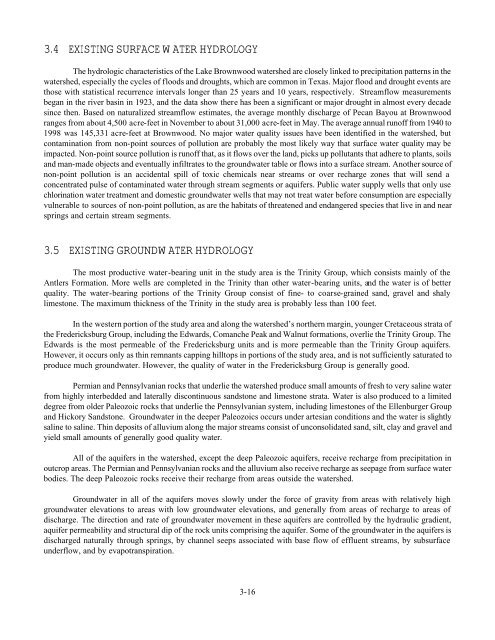Lake Brownwood Watershed - Texas State Soil and Water ...
Lake Brownwood Watershed - Texas State Soil and Water ...
Lake Brownwood Watershed - Texas State Soil and Water ...
You also want an ePaper? Increase the reach of your titles
YUMPU automatically turns print PDFs into web optimized ePapers that Google loves.
3.4 EXISTING SURFACE WATER HYDROLOGY<br />
The hydrologic characteristics of the <strong>Lake</strong> <strong>Brownwood</strong> watershed are closely linked to precipitation patterns in the<br />
watershed, especially the cycles of floods <strong>and</strong> droughts, which are common in <strong>Texas</strong>. Major flood <strong>and</strong> drought events are<br />
those with statistical recurrence intervals longer than 25 years <strong>and</strong> 10 years, respectively. Streamflow measurements<br />
began in the river basin in 1923, <strong>and</strong> the data show there has been a significant or major drought in almost every decade<br />
since then. Based on naturalized streamflow estimates, the average monthly discharge of Pecan Bayou at <strong>Brownwood</strong><br />
ranges from about 4,500 acre-feet in November to about 31,000 acre-feet in May. The average annual runoff from 1940 to<br />
1998 was 145,331 acre-feet at <strong>Brownwood</strong>. No major water quality issues have been identified in the watershed, but<br />
contamination from non-point sources of pollution are probably the most likely way that surface water quality may be<br />
impacted. Non-point source pollution is runoff that, as it flows over the l<strong>and</strong>, picks up pollutants that adhere to plants, soils<br />
<strong>and</strong> man-made objects <strong>and</strong> eventually infiltrates to the groundwater table or flows into a surface stream. Another source of<br />
non-point pollution is an accidental spill of toxic chemicals near streams or over recharge zones that will send a<br />
concentrated pulse of contaminated water through stream segments or aquifers. Public water supply wells that only use<br />
chlorination water treatment <strong>and</strong> domestic groundwater wells that may not treat water before consumption are especially<br />
vulnerable to sources of non-point pollution, as are the habitats of threatened <strong>and</strong> endangered species that live in <strong>and</strong> near<br />
springs <strong>and</strong> certain stream segments.<br />
3.5 EXISTING GROUNDWATER HYDROLOGY<br />
The most productive water-bearing unit in the study area is the Trinity Group, which consists mainly of the<br />
Antlers Formation. More wells are completed in the Trinity than other water-bearing units, <strong>and</strong> the water is of better<br />
quality. The water-bearing portions of the Trinity Group consist of fine- to coarse-grained s<strong>and</strong>, gravel <strong>and</strong> shaly<br />
limestone. The maximum thickness of the Trinity in the study area is probably less than 100 feet.<br />
In the western portion of the study area <strong>and</strong> along the watershed’s northern margin, younger Cretaceous strata of<br />
the Fredericksburg Group, including the Edwards, Comanche Peak <strong>and</strong> Walnut formations, overlie the Trinity Group. The<br />
Edwards is the most permeable of the Fredericksburg units <strong>and</strong> is more permeable than the Trinity Group aquifers.<br />
However, it occurs only as thin remnants capping hilltops in portions of the study area, <strong>and</strong> is not sufficiently saturated to<br />
produce much groundwater. However, the quality of water in the Fredericksburg Group is generally good.<br />
Permian <strong>and</strong> Pennsylvanian rocks that underlie the watershed produce small amounts of fresh to very saline water<br />
from highly interbedded <strong>and</strong> laterally discontinuous s<strong>and</strong>stone <strong>and</strong> limestone strata. <strong>Water</strong> is also produced to a limited<br />
degree from older Paleozoic rocks that underlie the Pennsylvanian system, including limestones of the Ellenburger Group<br />
<strong>and</strong> Hickory S<strong>and</strong>stone. Groundwater in the deeper Paleozoics occurs under artesian conditions <strong>and</strong> the water is slightly<br />
saline to saline. Thin deposits of alluvium along the major streams consist of unconsolidated s<strong>and</strong>, silt, clay <strong>and</strong> gravel <strong>and</strong><br />
yield small amounts of generally good quality water.<br />
All of the aquifers in the watershed, except the deep Paleozoic aquifers, receive recharge from precipitation in<br />
outcrop areas. The Permian <strong>and</strong> Pennsylvanian rocks <strong>and</strong> the alluvium also receive recharge as seepage from surface water<br />
bodies. The deep Paleozoic rocks receive their recharge from areas outside the watershed.<br />
Groundwater in all of the aquifers moves slowly under the force of gravity from areas with relatively high<br />
groundwater elevations to areas with low groundwater elevations, <strong>and</strong> generally from areas of recharge to areas of<br />
discharge. The direction <strong>and</strong> rate of groundwater movement in these aquifers are controlled by the hydraulic gradient,<br />
aquifer permeability <strong>and</strong> structural dip of the rock units comprising the aquifer. Some of the groundwater in the aquifers is<br />
discharged naturally through springs, by channel seeps associated with base flow of effluent streams, by subsurface<br />
underflow, <strong>and</strong> by evapotranspiration.<br />
3-16



